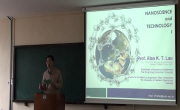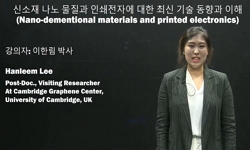Graphene has attracted much attention due to its unique structure and excellent properties such as low electronic scattering rate, high carrier mobility, high surface area and high optical transparency. For the extensive commercial applications for th...
http://chineseinput.net/에서 pinyin(병음)방식으로 중국어를 변환할 수 있습니다.
변환된 중국어를 복사하여 사용하시면 됩니다.
- 中文 을 입력하시려면 zhongwen을 입력하시고 space를누르시면됩니다.
- 北京 을 입력하시려면 beijing을 입력하시고 space를 누르시면 됩니다.
Transformation mechanism of graphene layers from carbon nanotubes using high DC pulse = 펄스 고전류를 이용한 탄소 나노튜브로부터 그라핀 레이어로의 형성기구
한글로보기부가정보
다국어 초록 (Multilingual Abstract)
Graphene has attracted much attention due to its unique structure and excellent properties such as low electronic scattering rate, high carrier mobility, high surface area and high optical transparency. For the extensive commercial applications for the future electronic device, the large-scaled fabrication techniques of high quality graphene layers are needed, in particular the number of graphene layers should be controlled because their electrical properties are influenced by the number of layers.
Since the discovery of graphene, several fabrication techniques for graphene have been introduced, such as, mechanical cleavage, silicon carbide sublimation, solvothermal synthesis, chemical vapor deposition (CVD), plasma etching and unzipping of CNTs. However, these techniques were not satisfied with all the two important factors ; the number of layers in graphene and large-scaled production.
This thesis disclose the new fabrication technique of various graphene layers with the controlled number of layers and large-scaled production using high direct current (DC) pulse. Because graphene has the basic structural elements of some carbon allotrops (graphite, CNTs, fullerenes, etc.) which can be transformed to the flat polycyclic aromatic hydro carbons which called graphene. CNT is a cylindral shape of two dimensional rolling sheet of carbon atoms and electrical current flows along the direction of CNT’s surface, so that high DC pulse can transform CNT to graphene layer. By using this technique, multi-walled carbon nanotubes (MWCNTS) and single-walled carbon nanotubes (SWCNTs) were transformed to multi-layer graphene and few-layer graphene (FLG), respectively. The mixture of CNTs and metal oxide can be changed to metal carbide layers. And, the exfoliation process using intercalation of alkali metal and microwave irradiation was effective in transforming the FLG to mono-layer graphene (MLG).
In conclusion, the pulsed current sintering (PCS) technique shows great potential for fabrication of graphene layers from the commercially available CNTs in a large scale. The use of this technique makes it possible to produce the various graphene with the controlled number of layers using the MWCNTs / SWCNTs with uniform distribution of diameters as the starting materials. This research can expand to the various application of graphene and metal carbide-based nano materials.
목차 (Table of Contents)
- Contents
- Abstract -------------------------------------------------------------------- 5
- Contents
- Abstract -------------------------------------------------------------------- 5
- Chapter 1. Literature Review --------------------------------------- 9
- 1.1. Description of graphene layers -------------------------------------------- 9
- 1.2. Structure of graphene layers ------------------------------------------------ 13
- 1.3. Properties of graphene layers ---------------------------------------------- 16
- 1.3.1. Electrical properties ------------------------------------------------------ 16
- 1.3.2. Optical properties -------------------------------------------------------- 18
- 1.3.3. Spin transport ------------------------------------------------------------- 19
- 1.3.4. Quantum Hall effect ----------------------------------------------------- 20
- 1.3.5. Thermal properties ------------------------------------------------------- 21
- 1.3.6. Mechanical properties --------------------------------------------------- 22
- 1.4. Potential applications of graphene layers ------------------------------- 23
- 1.4.1. Single molecule gas sensor --------------------------------------------- 24
- 1.4.2. New graphene device ---------------------------------------------------- 26
- 1.4.3. Integrated circuits -------------------------------------------------------- 26
- 1.4.4. Transparent conducting electrode -------------------------------------- 27
- 1.4.5. Ultra-capacitors ----------------------------------------------------------- 28
- 1.4.6. Graphene bio-device ----------------------------------------------------- 28
- 1.5. Fabrication Method --------------------------------------------------------- 29
- 1.5.1. Drawing method ---------------------------------------------------------- 29
- 1.5.2. Epitaxial growth ---------------------------------------------------------- 31
- 1.5.3. Hydrazine reduction ----------------------------------------------------- 32
- 1.5.4. Sodium reduction of ethanol -------------------------------------------- 32
- 1.5.5. Chemical vapor deposition ---------------------------------------------- 32
- 1.5.6. From nanotubes ----------------------------------------------------------- 32
- 1.6. References --------------------------------------------------------------------- 39
- Chapter 2. Fabrication of graphene layers from multi-walled
- carbon nanotubes using high DC pulse 43
- 2.1. Introduction ------------------------------------------------------------------- 43
- 2.2. Experimental procedure ---------------------------------------------------- 44
- 2.2.1. Preparation of starting materials --------------------------------------- 44
- 2.2.2. Fabrication of graphene ------------------------------------------------- 46
- 2.3. Results and discussion ------------------------------------------------------ 48
- 2.4. Summary ----------------------------------------------------------------------- 59
- 2.5. References ---------------------------------------------------------------------
- 60
- Chapter 3. Fabrication of few-layer graphene from single-
- walled carbon nanotubes using high DC pulse
- 64
- 3.1. Introduction ------------------------------------------------------------------- 64
- 3.2. Experimental procedure ---------------------------------------------------- 68
- 3.3. Results and discussion ------------------------------------------------------ 70
- 3.4. Summary ----------------------------------------------------------------------- 79
- 3.5. References --------------------------------------------------------------------- 80
- Chapter 4. Fabrication of mono-layer graphene using
- exfoliation process of few-layer graphene via
- microwave treatment 83
- 4.1. Introduction ------------------------------------------------------------------- 83
- 4.2. Experimental procedure ---------------------------------------------------- 84
- 4.2.1. Preparation of starting materials --------------------------------------- 84
- 4.2.2. Preparation of K+-THF organic solvent ------------------------------- 84
- 4.2.3. Exfoliation process ------------------------------------------------------- 86
- 4.3. Results and discussion ------------------------------------------------------ 86
- 4.4. Summary ---------------------------------------------------------------------- 94
- 4.5. References --------------------------------------------------------------------- 95
- Chapter 5. Fabrication of transition metal carbide layers
- / laminar using high DC pulse 99
- 5.1. Introduction ------------------------------------------------------------------- 99
- 5.2. Experimental procedure ---------------------------------------------------- 100
- 5.2.1. Single-phase titanium carbide layers ---------------------------------- 102
- 5.2.2. Single-phase tungsten carbide layers ---------------------------------- 102
- 5.3. Results and discussion ------------------------------------------------------ 104
- 5.3.1. Single-phase titanium carbide laminar -------------------------------- 104
- 5.3.2. Single-phase tungsten carbide laminar -------------------------------- 112
- 5.4. Summary ----------------------------------------------------------------------- 119
- 5.5. References --------------------------------------------------------------------- 120
- Chapter 6. Conclusion ---------------------------------------------- 123
- Figure Captions --------------------------------------------------------- 125
- Acknowledgement ------------------------------------------------------ 130











